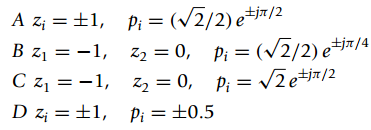We are given a noisy signal x(t) = s(t) + η(t) where s(t) is the desired signal
Question:
x(t) = s(t) + η(t)
where s(t) is the desired signal and η(t) is additive noise. From experience, we know that the average power of the desired signal and the noise has finite support. That is
|S(f)|2 = 0 f ‰¥ 10 kHz
|N(f)|2 = 0 f ‰¥ 20 kHz
where S(f) and N(f) are the Fourier transforms of s(t) and η(t) in terms of the frequency f(see top figure in Figure 10.19). Suppose we use the system shown at the bottom of Figure 10.19 to process x(t)to make it €œlook better,€ i.e., reduce the effects of the noise without distorting the desired signal.
We have four second order filters (A to D) to choose from. The gain K = 0.25 for each and the poles {pi} and zeros {zi} are

where i =1, 2.
(a) Suppose that for hardware reasons the sampling rate fs you can use is limited to 10, 20, 30, 40, or 50 kHz. Select fs from those available and explain the reason for your choice.
(b) Select an appropriate filter from those available and explain the reason for your choice.
(c) Determine H(z) = KN(z)/D(z) for the filter of your choice, where N(z) and D(z) are polynomial in z with real coefficients.
(d) Determine and sketch |H(ejω)|, for €“Ï€ ‰¤ ω ‰¤ Ï€. Evaluate carefully the values at ω = 0, ±Ï€.
Figure 10.19:
![|S(S)? |N()P f (KHz) 10 r[n] y/n] H(2) x(t) y(t) Sampler Ideal D/A f.](https://dsd5zvtm8ll6.cloudfront.net/si.question.images/images/question_images/1545/8/1/7/8815c234f19878d31545800466445.jpg)
Step by Step Answer:






